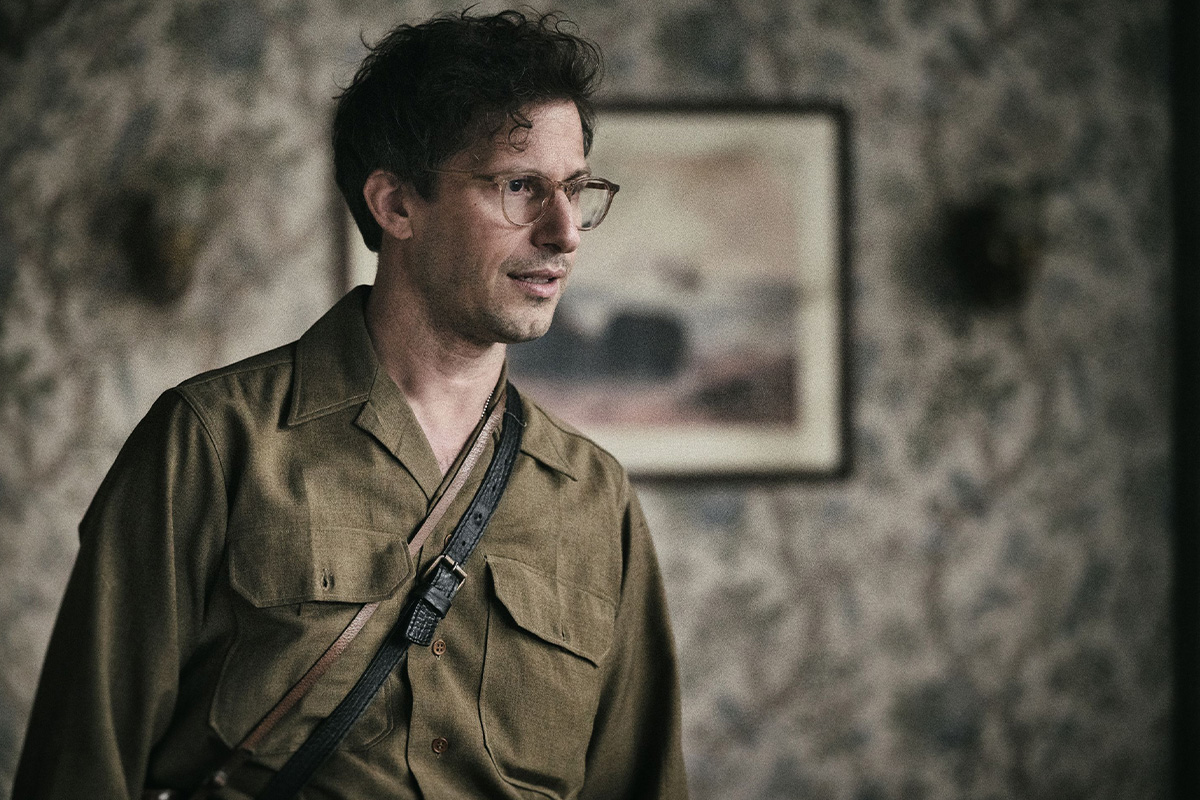Editorial note: Spoilers ahead for the movie “Lee.”
When the news came out last year that Jewish comedian Andy Samberg would be taking on his first dramatic role in the World War II biopic slash thriller “Lee,” I was conflicted. Would it even be possible to see past the playfully silly Andy Samberg of “Get in the Cage with Nicolas Cage and Nicolas Cage” on SNL or breaking out into “I Want It That Way” during a police line-up on “Brooklyn Nine-Nine” and believe him in an earnest performance? Even Samberg himself has revealed that he was “a bit trepidatious” to take the role of Life Magazine war correspondent David “Davey” E. Scherman. “I didn’t want to ruin the movie,” he said, albeit jokingly, in an interview with the publication Digital Spy.
As it turns out, the answer is a resounding yes, it is possible to see past all his previous performances. Samberg is more than just believable as a Jewish photographer and man bearing witness to World War II and the Holocaust. He’s good.
“Lee,” which was released on Sept. 27, follows American model-turned-photographer Lee Miller (Kate Winslet) in the years just before World War II and at the beginning of the war, as she decides that her way of making a difference will be documenting Hitler’s destruction for Vogue Magazine. The movie deals with the obstacles she experienced as a woman in a field dominated by men, the price she paid later in life as a mother, her own traumas from before the war and the new pain and violence she bears witness to on the frontlines.
Throughout the majority of the film, Lee is accompanied by Davey Scherman. Together they photograph the Battle of St. Malo, capturing the use of napalm on film, French female collaborators having their head’s publicly shaved, the dead bodies of German families who partook in suicide pacts, the liberation of Dachau concentration camp and Hitler’s Munich apartment. Davey is able to keep a level head in these moments, despite his own Jewishness. Right up until he finishes photographing Hitler’s bathtub, that is.
It’s in this scene that Andy Samberg gives a masterclass performance in Jewish pain. Davey and Lee emerge from the bathroom in Hitler’s apartment, having taken what would become extremely famous photos of themselves bathing in the Führer’s bathtub. Lee seems to be reveling in having been able to simultaneously take a warm bath and mock Hitler in her photos. But Davey almost stumbles out of the bathroom.
Earlier in the day, Lee and Davey had photographed Dachau. They covered their mouths and noses with scarves, trying to avoid the stench, as they documented American soldiers opening a cattle car full of corpses. As Lee photographs the train interior, Davey looks down the line of train cars, realizing, in horror, that they too are filled with dead bodies. Moments later, they enter a building in the camp filled with the bodies of emaciated, dead concentration camp prisoners that the Nazis didn’t have time to burn. Lee, whimpering, asks Davey to do the flash while she takes a photo of the pile. Davey does his job, but looks away immediately after. “Let’s go,” he says quietly.
That all seems to hit him in the moment after he leaves Hitler’s bathroom. Davey quietly begins to sob and Lee embraces him tightly. “All those people… all those people,” the hardened war correspondent cries into his friend’s arms. “They were my people.”
For any Jew, Samberg’s expression of Jewish pain isn’t just recognizable. It’s tangible. I myself felt it when I visited Dachau 67 years after Lee Miller and Davey Scherman had been there. In a scene which is just over a minute long, Samberg’s performance encapsulates the horror, compartmentalization, disbelief, anguish and familial connection a Jewish person feels when bearing witness to the Holocaust.
Just before the movie’s premiere, actress Kate Winslet told the BBC that Andy Samberg’s reaction to being cast was, ““My [mom’s] going to be so proud.” Now that “Lee” is out, it’s clear that Samberg didn’t just make his mom proud — he did the entire Jewish community proud.



